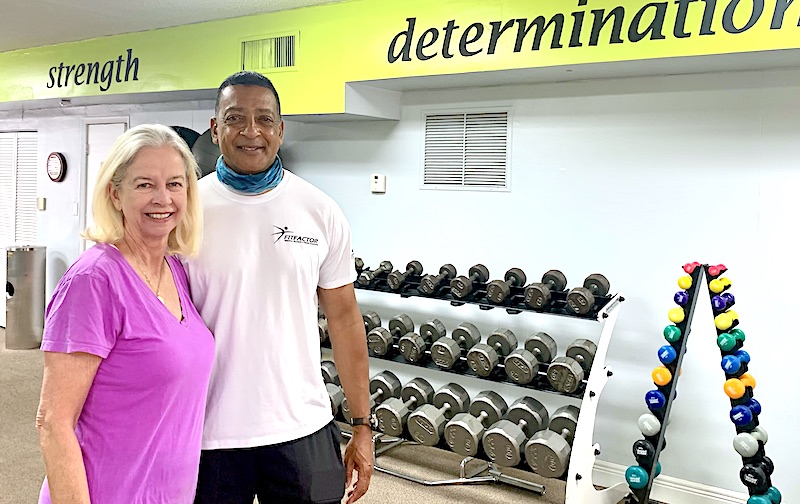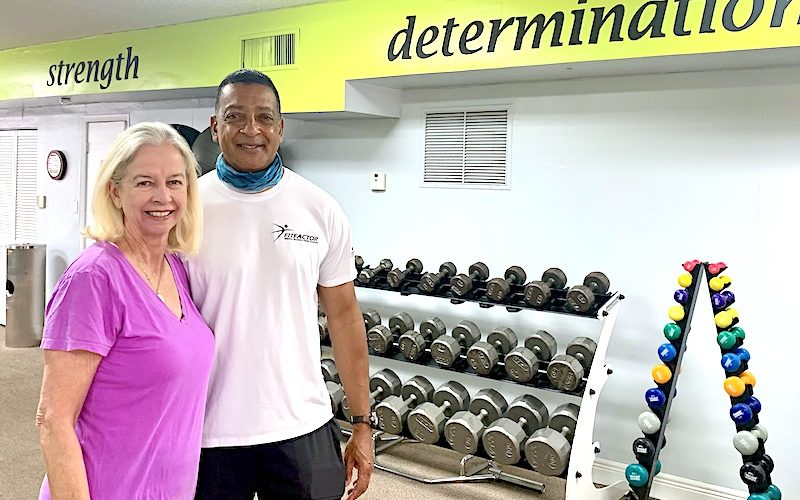 For Pat Harlow, the symptoms came occasionally at first. She couldn’t remember words. She had double vision and numbness on one side.
For Pat Harlow, the symptoms came occasionally at first. She couldn’t remember words. She had double vision and numbness on one side.
Eventually, after a particularly bad episode, Pat was diagnosed with multiple sclerosis at age 48. She kept going to work for 15 years and “pretending that I’m normal,” she says.
But after a fall required two surgeries, Pat’s husband started suggesting she join a gym – an idea she refused at first.
Now, at 71, Pat’s been working with a trainer at the gym three days a week for three years. She even works out at home alone on other days. She absolutely loves it – and is proof positive that exercise later in life can benefit anyone, regardless of physical ability.
While there is no cure for MS, the exercise helps with her symptoms, as well as her emotions and social interaction
“I really did not know that exercise could make such a difference,” she says.
A Disease of the Central Nervous System
The National MS Society says about 1 million Americans have the disease. Most are diagnosed between 20 and 50, and it is two to three times more common among women than men.
“Multiple sclerosis (MS) is an unpredictable disease of the central nervous system that disrupts the flow of information within the brain, and between the brain and body,” the society says. “The cause of MS is still unknown. Scientists believe that a combination of environmental and genetic factors contribute to the risk of developing MS.”
An early symptom is often an MS hug, or a squeezing sensation around the body. Other symptoms include fatigue, trouble walking, numbness, and muscle spasms.
Exercise is helpful in managing many symptoms, the MS society says.
“Many MS patients avoid exercise, thinking it will aggravate pain or make their fatigue worse,” according to Penn Medicine at the University of Pennsylvania. “But research has shown that the opposite is true – exercise can actually improve symptoms.
The best types of exercise for it are aerobic, stretching, and progressive strength training, Penn doctors say. And we agree that everyone over age 50 or so needs regular exercise to maintain cardiovascular health, agility, and muscle.
Strengthening the Core and Legs
Pat’s trainer works her legs and core, using weights, balance devices, and elliptical trainers. And yes, she does get tired during some of the exercises, but she loves the results of her efforts.
“I’m not down for the count – because I’ve worked out,” she says. “The best part of the workout is when it’s done.”
She now can walk without a cane. She can drive, bring in the groceries, and handle activities of daily living – which include playing with her 5-year-old grandkids. Her balance is better. And her doctors are pleased with the results.
“The world gets smaller with any kind of disability, and there’s a lot of things I can’t do anymore,” says Pat, who credits her strong faith for her resilience and discipline. “I just didn’t want my world to continue to get small. Exercise has made a huge difference.
“We don’t always get to make some critical decision in life — they’re made for us. And then it’s how we respond.”
Holly Kouvo is a personal trainer, functional aging specialist, senior fitness specialist, brain health trainer, writer, and speaker.

